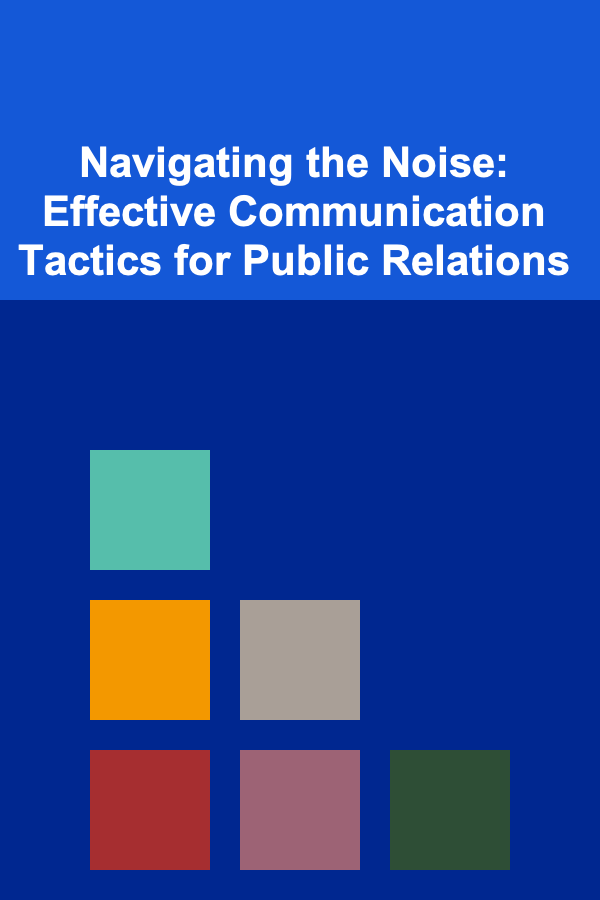
Navigating the Noise: Effective Communication Tactics for Public Relations
ebook include PDF & Audio bundle (Micro Guide)
$12.99$8.99
Limited Time Offer! Order within the next:

In today's fast-paced, information-saturated world, public relations (PR) professionals face the daunting task of cutting through the noise to ensure their messages reach and resonate with their target audience. With the rise of digital media, social platforms, and an overabundance of information, it has become increasingly difficult to get noticed and maintain a positive reputation. In this actionable guide, we will explore key communication tactics that can help PR professionals navigate the noise, deliver messages effectively, and drive meaningful engagement.
Understanding the Communication Landscape
Before diving into the tactical approaches, it is essential to understand the environment PR professionals are operating within. The communication landscape has evolved drastically over the past two decades, driven by technology, social media, and shifting audience behaviors. Today, organizations are competing not only against competitors but also against the overwhelming volume of information that audiences consume daily.
The Challenge of Noise in Communication
The "noise" in communication refers to any factor that distorts, interrupts, or distracts from the message being conveyed. In the digital age, this noise comes from a variety of sources, including:
- Social Media Overload: Platforms like Twitter, Facebook, and Instagram are bombarded with endless posts, ads, and interactions. Messages often get lost in the feed, buried under competing content.
- Information Overload: Audiences are inundated with news, blogs, videos, and updates, leading to reduced attention spans and increased resistance to traditional marketing and PR methods.
- Misinformation: False or misleading information spreads quickly, particularly on social media, making it harder for PR professionals to maintain trust and credibility.
- Crisis and Reputation Management: Negative news cycles, public criticism, and scandals can amplify the noise and threaten the reputation of an organization, requiring swift and effective communication responses.
In this challenging environment, mastering communication tactics is more critical than ever. Let's explore how PR professionals can effectively cut through the noise.
Crafting a Clear and Concise Message
The cornerstone of effective communication in public relations is clarity. A message that is clear, direct, and easy to understand is more likely to resonate with an audience and stick in their minds. In a world where attention spans are shrinking, brevity is not just important---it's essential.
Why Clarity Matters
- Avoiding Confusion: If the message is too complex or ambiguous, it will likely get lost in the noise.
- Strengthening Recall: Clear and concise messages are easier to remember, ensuring the audience retains the key points of your communication.
- Reducing Misinterpretation: A well-crafted message minimizes the risk of misinterpretation or miscommunication, which can damage the brand's reputation.
Tips for Crafting Clear Messages
- Keep it Simple: Avoid jargon and overly complex language. Use simple words and sentence structures.
- Focus on One Key Idea: Avoid overwhelming the audience with too much information. Instead, center your message around one core idea.
- Use Active Voice: Active voice is more direct and engaging than passive voice. For example, say "We launched a new product" instead of "A new product was launched by us."
- Make it Actionable: Ensure your message includes a clear call to action (CTA), guiding the audience on what to do next.
Example:
If a company is launching a new app, the message might look like this:
"Download our new app today for a faster, more secure shopping experience. Start shopping smarter now!"
This message is clear, concise, and provides the audience with a specific next step.
Leveraging Emotional Appeal
In addition to clarity, emotional appeal plays a crucial role in communication. When audiences connect emotionally with a message, they are more likely to engage with it, remember it, and take action. Emotional storytelling can evoke empathy, excitement, trust, or even humor, which helps make the message more memorable.
Why Emotional Appeal is Powerful
- Building Trust: Messages that appeal to emotions help foster trust and a sense of connection with the brand.
- Creating Memorable Experiences: Emotional connections often lead to positive associations that last longer than rational arguments alone.
- Encouraging Action: Emotional messages often prompt audiences to act in a way that aligns with the brand's goals, whether that's making a purchase, sharing the content, or spreading the word.
How to Use Emotional Appeal Effectively
- Tell Stories: People connect with stories, especially those that are relatable or compelling. Use storytelling to bring your message to life.
- Highlight Human Impact: Focus on how the brand or message affects real people. Showcase customer success stories or highlight social responsibility efforts.
- Be Authentic: Emotional appeal must be genuine. Audiences can quickly detect when a message feels insincere, which can damage credibility.
Example:
An NGO running a donation campaign might use a message like:
"Your donation can provide a meal to a child in need. Together, we can change their lives, one meal at a time."
This message appeals to the audience's sense of compassion and the desire to make a difference.
Mastering the Art of Timing
Timing is everything in public relations. The effectiveness of a message can be significantly impacted by when it is delivered. In today's 24/7 news cycle and constant social media chatter, sending out a message at the wrong time can result in it being lost in the noise.
Why Timing Matters
- Capturing Attention: Timing ensures that your message reaches the audience at a moment when they are most receptive to it.
- Seizing the Moment: In PR, there are times when the media or public are already focused on an issue, and your message can take advantage of that momentum.
- Crisis Management: In a crisis, timely responses are crucial. A delay can amplify negative perceptions and increase the damage.
How to Master Timing
- Monitor Trends and News: Stay updated on industry trends, breaking news, and current events. Align your messages with relevant discussions to increase visibility and engagement.
- Use Data: Leverage data and analytics to understand when your audience is most active on social media or other communication channels.
- Be Ready to Respond Quickly: In times of crisis or when a major opportunity arises, speed is critical. Have a crisis communication plan in place to deliver timely and appropriate responses.
Example:
A tech company might schedule the release of a new product right after a major event or conference where industry leaders are discussing similar topics, ensuring the product gets the attention it deserves.
Embracing Multi-Channel Communication
In an age where audiences consume content through various mediums---social media, blogs, email, podcasts, news outlets---public relations professionals must ensure their messages are reaching their audience through the right channels. A multi-channel approach amplifies the message and allows for deeper engagement.
Why Multi-Channel Communication Works
- Increased Reach: Using multiple platforms helps ensure that your message reaches a diverse audience, from tech-savvy millennials to traditional media consumers.
- Reinforced Message: Repetition across different platforms reinforces the core message, making it more likely to be remembered.
- Engagement and Interaction: Some channels allow for two-way communication, enabling your audience to interact with the brand, ask questions, and share opinions.
How to Execute a Multi-Channel Strategy
- Know Your Channels: Choose the right platforms based on your target audience. For instance, LinkedIn is ideal for B2B communication, while Instagram is more suited for lifestyle brands.
- Adapt Your Message: Tailor your message to fit the format of each channel. A tweet might be brief and punchy, while a blog post can go into greater detail.
- Track Performance: Use analytics to measure the effectiveness of each channel and adjust your strategy accordingly.
Example:
For a new product launch, a company might:
- Share teaser posts on Instagram with behind-the-scenes footage.
- Publish a detailed blog post explaining the product features.
- Send out a press release to major media outlets.
- Host a live Q&A on Twitter for interested customers.
Monitoring and Responding to Feedback
Finally, effective communication is a two-way process. It's not enough to send out a message and hope it sticks; PR professionals must also monitor the feedback and respond accordingly. This includes listening to both positive and negative reactions and engaging with the audience in a constructive way.
Why Feedback is Crucial
- Building Trust: Actively listening to and responding to feedback shows that the brand values its audience and cares about their opinions.
- Improving Messages: Feedback can provide insights into how well the message was received, which can help refine future communication strategies.
- Managing Crises: In times of crisis, timely and thoughtful responses to negative feedback are critical to protecting the brand's reputation.
How to Manage Feedback
- Monitor Social Media: Use social listening tools to keep track of online conversations about your brand.
- Engage in Real-Time: Respond promptly to questions, comments, and concerns, particularly on social media platforms.
- Be Transparent: Acknowledge mistakes and be open about what steps are being taken to resolve any issues.
Example:
If a customer posts a negative review about a product, a PR professional might respond with:
"Thank you for your feedback. We're sorry to hear about your experience and would love to help resolve the issue. Please DM us so we can assist you further."
Conclusion
Navigating the noise in today's communication landscape requires a strategic, multi-faceted approach. By crafting clear, compelling messages, appealing to emotions, mastering timing, leveraging multiple channels, and actively engaging with feedback, PR professionals can break through the clutter and create meaningful, lasting connections with their audience. In an age of information overload, these tactics are not just useful---they are essential for ensuring your message stands out and makes a real impact.

How to Promote Transparency in Charity Organizations
Read More
How to Soundproof a Nursery for Better Baby Sleep
Read More
How to Use Clear Pouches for Small School Supplies
Read More
Supporting Wildlife Corridors Globally: A Deep Dive
Read More
How to Ace Your Job Interview: A Pre-Interview To-Do List for Nervous Candidates
Read More
Address Labels for Teachers: A Back-to-School Guide
Read MoreOther Products

How to Promote Transparency in Charity Organizations
Read More
How to Soundproof a Nursery for Better Baby Sleep
Read More
How to Use Clear Pouches for Small School Supplies
Read More
Supporting Wildlife Corridors Globally: A Deep Dive
Read More
How to Ace Your Job Interview: A Pre-Interview To-Do List for Nervous Candidates
Read More